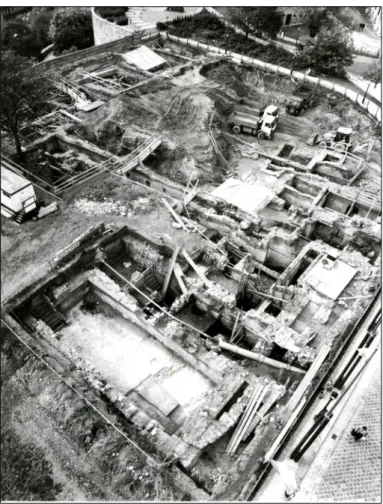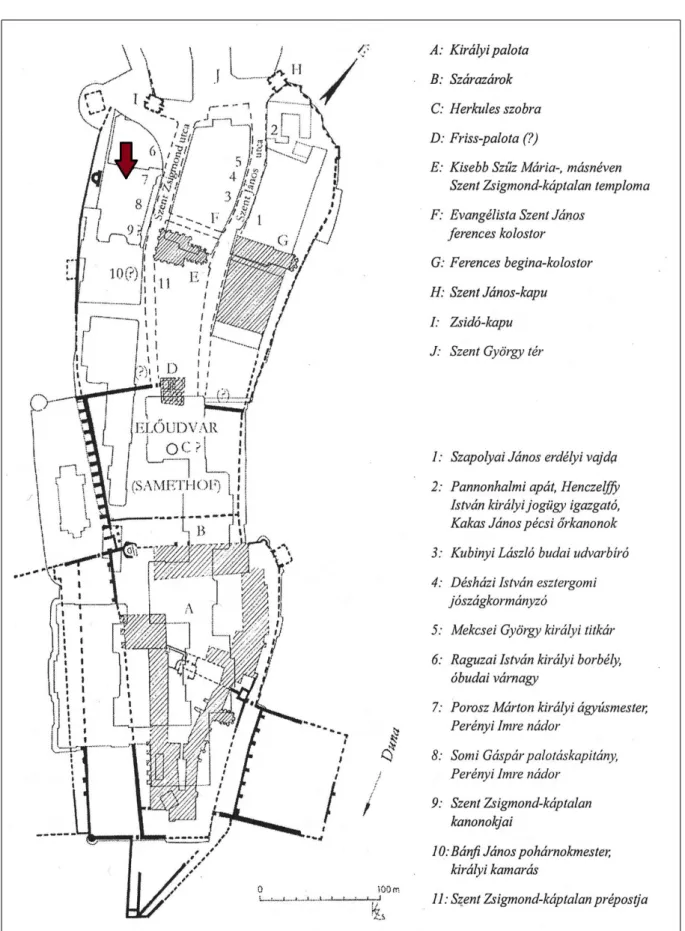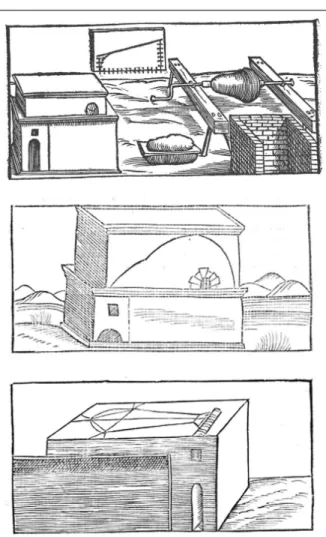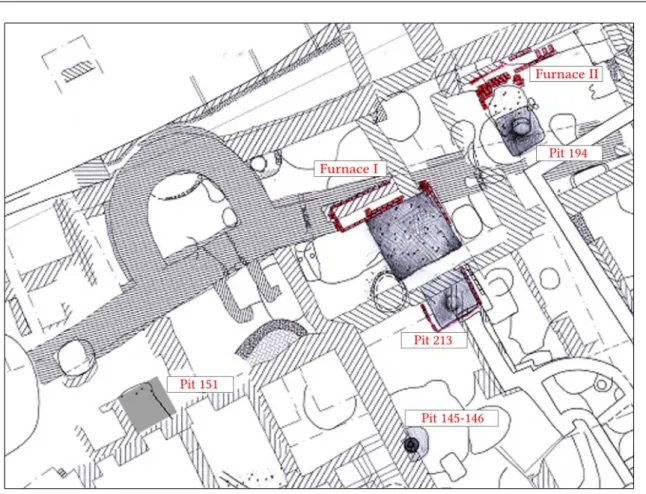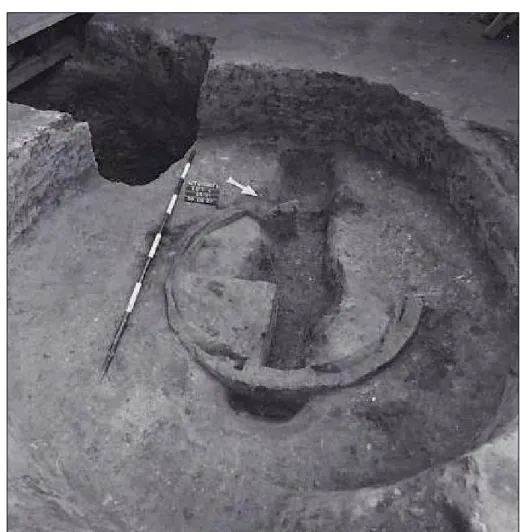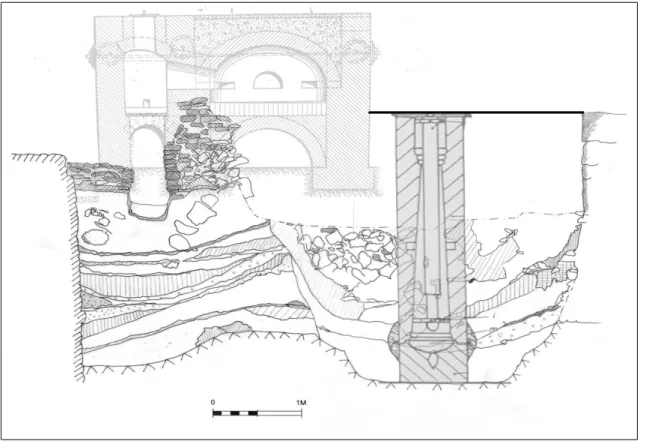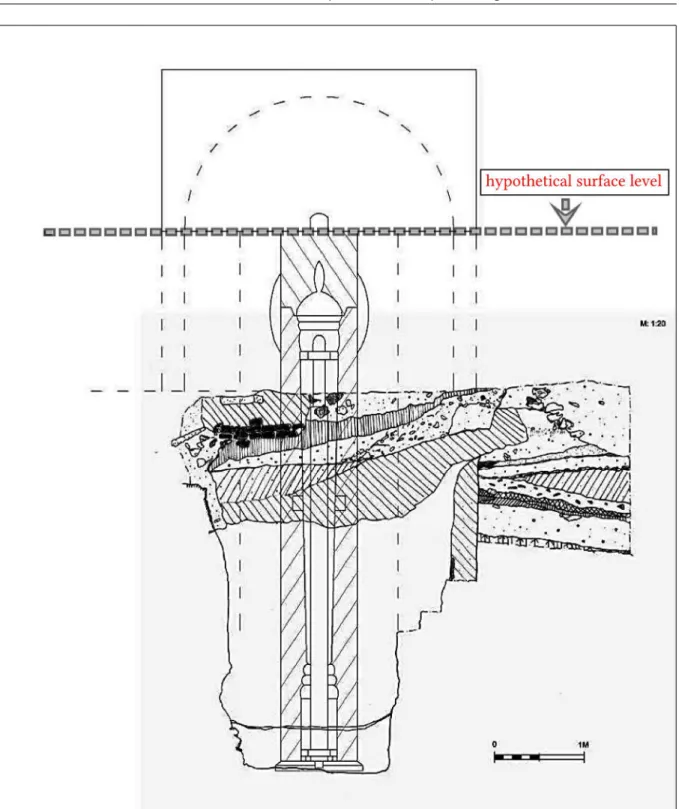Dissertationes Archaeologicae
ex Instituto Archaeologico
Universitatis de Rolando Eötvös nominatae Ser. 3. No. 2.
Budapest 2014
Dissertationes Archaeologicae ex Instituto Archaeologico Universitatis de Rolando Eötvös nominatae
Ser. 3. No. 2.
Editor-in-chief:
Dávid Bartus Editorial board:
László Bartosiewicz László Borhy
István Feld Gábor Kalla
Pál Raczky Miklós Szabó Tivadar Vida Technical editors:
Dávid Bartus Gábor Váczi András Bödőcs
Dániel Szabó Proofreading:
Szilvia Szöllősi
Available online at http://dissarch.elte.hu Contact: dissarch@btk.elte.hu
© Eötvös Loránd University, Institute of Archaeological Sciences Budapest 2014
Contents
Selected papers of the XI . Hungarian Conference on Classical Studies
Ferenc Barna 9
Venus mit Waffen. Die Darstellungen und die Rolle der Göttin in der Münzpropaganda der Zeit der Soldatenkaiser (235–284 n. Chr.)
Dénes Gabler 45
A belső vámok szerepe a rajnai és a dunai provinciák importált kerámiaspektrumában
Lajos Mathédesz 67
Római bélyeges téglák a komáromi Duna Menti Múzeum yűjteményében
Katalin Ottományi 97
Újabb római vicusok Aquincum territoriumán
Eszter Süvegh 143
Hellenistic grotesque terracotta figurines. Problems of iconographical interpretation
András Szabó 157
Some notes on the rings with sacred inscriptions from Pannonia
István Vida 171
The coinage of Flavia Maxima Helena
Articles
Gábor Tarbay 179
Late Bronze Age depot from the foothills of the Pilis Mountains
Csilla Sáró 299
Roman brooches from Paks-Gyapa – Rosti-puszta
András Bödőcs – Gábor Kovács – Krisztián Anderkó 321
The impact of the roman agriculture on the territory of Savaria
Lajos Juhász 333
Two new Roman bronzes with Suebian nodus from Brigetio
Field reports
Zsolt Mester – Norbert Faragó – Attila Király 351
The first in situ Old Stone Age assemblage from the Rába Valley, Northwestern Hungary
Pál Raczky – Alexandra Anders – Norbert Faragó – Gábor Márkus 363 Short report on the 2014 excavations at Polgár-Csőszhalom
Daniel Neumann – Zsuzsanna Siklósi – Roman Scholz – Márton Szilágyi 377 Preliminary Report on the first season of fieldwork in Berettyóújfalu-Szilhalom
Márton Szilágyi – András Füzesi – Attila Virág – Mihály Gasparik 405 A Palaeolithic mammoth bone deposit and a Late Copper Age Baden settlement and enclosure
Preliminary report on the rescue excavation at Szurdokpüspöki – Hosszú-dűlő II–III. (M21 site No. 6–7)
Kristóf Fülöp – Gábor Váczi 413
Preliminary report on the excavation of a new Late Bronze Age cemetery from Jobbáyi (North Hungary)
Lőrinc Timár – Zoltán Czajlik – András Bödőcs – Sándor Puszta 423 Geophysical prospection on the Pâture du Couvent (Bibracte, France). The campaign of 2014
Dávid Bartus – László Borhy – Gabriella Delbó – Emese Számadó 431 Short report on the excavations in the civil town of Brigetio (Szőny-Vásártér) in 2014
Dávid Bartus – László Borhy – Emese Számadó 437
A new Roman bath in the canabae of Brigetio
Short report on the excavations at the site Szőny-Dunapart in 2014 Dávid Bartus – László Borhy – Zoltán Czajlik – Balázs Holl –
Sándor Puszta – László Rupnik 451
Topographical research in the canabae of Brigetio in 2014
Zoltán Czajlik – Sándor Berecki – László Rupnik 459
Aerial Geoarchaeological Survey in the Valleys of the Mureş and Arieş Rivers (2009-2013)
Maxim Mordovin 485
Short report on the excavations in 2014 of the Department of Hungarian Medieval and Early Modern Archaeoloy (Eötvös Loránd University, Budapest)
Excavations at Castles Čabraď and Drégely, and at the Pauline Friary at Sáska
Thesis Abstracts
Piroska Csengeri 501
Late groups of the Alföld Linear Pottery culture in north-eastern Hungary New results of the research in Borsod-Abaúj-Zemplén County
Ádám Bíró 519
Weapons in the 10–11th century Carpathian Basin
Studies in weapon technoloy and methodoloy – rigid bow applications and southern import swords in the archaeological material
Márta Daróczi-Szabó 541
Animal remains from the mid 12th–13th century (Árpád Period) village of Kána, Hungary
Károly Belényesy 549
A 15th–16th century cannon foundry workshop in Buda
Craftsmen and technoloy of cannon moulding and the transformation of military technoloy from the Renaissance to the Post Medieval Period
István Ringer 561 Manorial and urban manufactories in the 17th century in Sárospatak
Bibliography
László Borhy 565
Bibliography of the excavations in Brigetio (1992–2014)
A 15th–16th century cannon foundry workshop in Buda
Craftsmen and technology of cannon moulding and the transformation of military technology from the Renaissance to the Post Medieval Period
Károly Belényesy
belenyesy@gmail.com
Abstract of PhD thesis submitted in 2014 to the Archaeology Doctoral Programme, Doctoral School of History, Eötvös Loránd University, Budapest under the supervision of András Kubinyi and István Feld.
Introduction
The reconstruction and architectural rehabilitation of the Szent György Square was a very late but very important part of the post-war renovation (following the demolitions of World War II in 1944–45) of the Castle Hill at Buda. Archaeological excavations have been carried out in Buda (between the Royal Palace and the Fehérvári Gate) between 1994 and 2003. The goal of these excavations was to launch an urban planning and space reconstruction project for a me- dieval district in the foreground of the former Royal Palace. The remains of a medieval foundry, that is, a moulding workshop were unearthed on some plots (6 and 8 Szent György Street) during these works. We have excavated the fragments of two brick-built furnaces and four moulding pits close to the medieval city wall. These pits were full with the waste of pre- vious casts: moulded bricks, alloy and bronze pieces (flows and drops) of the casts and clay fragments from the mould. The size of the furnaces and the shape of the pits dug next to them all referred to the production of huge and heavy bronze objects. Therefore, we can identify these remains as the royal cannon foundry established by Jacobus Maryanwerder de Pruscia.
This workshop was known from some written sources of the 15th and 16th centuries.
Structure
The goal of this dissertation is to reconstruct and present the cannon foundry working in Buda along the 15th and 16th centuries. It is based on the excavated archaeological material and the written sources relevant to history and technology.
The first part of the dissertation deals with the written military, economic and topographical history evidence of this workshop. This is followed by a comprehensive analysis of the sources relating to the casting history of the 15th and 16th centuries. This helps to demon- strate the contemporaneous procedure of cannon production. In the dissertation I presented a theoretical model of a cannon foundry as based on the written evidence.
In the next part, I compared the archaeological material of the excavated site with this theo- retical model. The small finds were also analysed with scientific methods. This helped to un- derstand excavated features and small finds and supported a theoretical structural recon- struction of the site and of the moulds.
DissArch Ser. 3. No. 2 (2014) 549–560.
K. Belényesy: A 15th–16th century cannon foundry workshop in Buda
Finally, the internal structural context of the archaeological site made it possible to deter- mine periods and internal relations of the site and the workshop areas inside of it.
Written sources concerning the foundry at Buda
The amount of the available written evidence is surprisingly large if compared to the general survival of the archival sources from the 15th century. There are charters from the Batthyányi archive (concerning the possession of Rohonc), well elaborated sources for house owners in the Szent György Street (the medieval Szent Zsigmond Street) in the city of Buda and royal reckoning books from the 1494 and 1495. This later describes the royal mili- tary campaign of Wladislas II against Lawrence of Újlak, in which campaign the cannon foundry of Buda and its master played a crucial role.
The workshop leader of the cannon foundry, Jacobus Marijwerder (Maryanwerder, Morgan- werder) de Pruscia, originates very likely from Marienberg, the Prussian settlement south of Malbork (today Kwidzyn in Poland). He most probably met and joined King Matthias during his Austrian campaign. His various services and support of the king were honoured by a do- nation in 1478: the villages of Hodász, Csajta, Perenye, Czag, Velem and Gwor, and the cas- tle and town of Rohonc. Although there is no evidence for that, it is very likely that this royal master had soon moved to Buda, in the neighbourhood of the Royal Palace. The house of „Jacobi Bombardiste familiarum regie maiestatis” is first mentioned in a charter from 1489.
It was located in the Saint Sigismund Street (Szent Zsigmond Street) leading to the castle, next to the house of the royal barber, Stephen of Raguza. „Jacobus de Rohoncz pixidarius Regius” sold his newly acquired possession of Rohonc in several pieces between May 1490 and January 1491. His successor and official heir, Martinus de Pruscia „Bombardius regie maiestatis” is mentioned around 1505. He is also mentioned in 1515 as a neighbour, and in 1518 as someone who sold his house a few years before for 1200 Forints to Emerich Perényi and his sons, the former southern neighbours of the plot.
The royal reckoning books of 1494/1495
The archive of the royal accounts is an important evidence for the investigation of the com- merce and state budget in the era of the Jagiellonian dynasty. Some data in it also refer to the military campaign of the king against Lawrence of Újlak. This information helps clarify- ing the role of Master Jacob and the royal artillery in this campaign. Although the well- spread data that all the royal cannons of the military enterprise had been casted by Jacob is not fully supported by evidence, this source is very informative concerning the artillery preparations at the late 15th century, the industrial achievement of the cooperation of sev- eral craftsmen and the role of the royal cannon master and artillery in general. The majority of the data in these books refer to supplementing munitions, producing gunpowder and moving cannons; only the casting of two cannons is fully evidenced.
The topography of the cannon foundry in Buda
The dissertation also considers topographic aspects in addition to the technological ones.
The identification of this very special industrial area also helps localising the plots of the me- dieval „platea Sancti Sigismundi”, the later Szent György Street. There is a special investigation
550
K. Belényesy: A 15th–16th century cannon foundry workshop in Buda
in the dissertation dedicated to the internal and external relationships of the foundry: the area of the workshop, its relation to the Royal Palace and fitting to the urban structure of late medieval and early modern Buda.
Moulding and casting bronze cannons at about 1500
The end of the 15th century is not simply the age of a military revolution, the general spread of the usage of artillery and firearms, but also the time of the establishment of the modern idea and literature of mining, geology and metallurgy. Incidentally, as referred to by the ex- cavated remains of the furnace, the time of existence of the Buda cannon foundry and a shift in the Bronze casting technology coincide. A new type of cannon furnace appears: the so-called flame furnace.
While the casting technology had slightly changed thanks to the quick spread of the flame furnace, the mould-making technology had remained basically the same.
We can include a new source of evidence, because after this time the industrial technology of cannon casting procedure remained more or less the same for approximately 300 years.
Analysing the relevant data of the 17th and 18th centuries, we can also use the results for investigating the late medieval casting and mould-making technologies.
The archaeological material of the workshop at Buda
The dissertation investigates the features and small finds of the excavated foundry in the fol- lowing structure:
• Identification of the material of the cannon foundry.
• Reconstruction of the historical industrial surroundings on the basis of comparing the excavation material and the sources of the history of technology.
• Moulds and casts as reconstructed from the finds.
• Relative chronology of the workshop.
Results
The given strict technology – as referred to by the sources – and the facilities connected to this technological process create a direct logical line, in which the missing elements can be inferred. Therefore, the fragments of the furnaces and pits are structural and technological elements, which refer to the whole procedure. Consequently, we can create models for the former medieval workshop also considering the local specialities.
Based on all the above evidence, we could reconstruct five workshop districts on the two exca- vated plots of the Szent György Street. We can also determine the size, weight and shape of the objects. Perhaps the most interesting is the identification and theoretical reconstruction of the cannon called „…tormenta inusitate magnitudinis…” by Bonfini. We can presumably iden- tify the mould remains of a cannon with extraordinary dimensions (5705 kg, at least 4,5 m long, 40 cm diameter) as the huge cannon which had been installed by Master Jacob on the field during the campaign against Újlaki.
551
K. Belényesy: A 15th–16th century cannon foundry workshop in Buda
Although the evidence is not sufficient to create a solid typology for the firearms of the era, it is enough to set up a very likely hypothesis. At about 1500 the cannon workshop in Buda produced siege guns with one bigger and two smaller calibres, howitzers and a bell of more than 300 kg (with 100–120 cm lower diameter and 110–130 cm height).
Summary
Although the relative chronology and periods of the workshop could not be fully clarified, thanks to the written sources, the excavated material and the workshop districts could be very well located both in time and space.
According to the small finds, the stratigraphic observations and the numerous separated casting pits and furnaces, we have excavated the remains of several, non-contemporaneous casting procedures of cannons and bells. Only their succession in time, i.e. their relative chronological relationship remains unclear.
Because of the cannons, we can connect these casts to military actions and to the person of the king. In the case of the bells the customer was not necessarily the king and the produc- tion of smaller series is also probable.
Despite of the close neighbourhood of the Royal Palace, this foundry was not a royal mili- tary factory, but a privately owned manufacture, a cannon foundry, which also satisfied royal orders.
The manufacture run by first by Jacob and later by Martin is still interesting. Its speciality is its permanency; because of the typical mobility of the cannon foundry masters it is rather unique – although not exceptional – to settle in a city and create master dynasties for a longer time.
We know for sure that Martin and his wife, Margaret, sold their house in Buda in the 1510s.
Martin could settle and get further orders elsewhere, but these are not known from the sources. The cannon foundry in the medieval Szent Zsigmond Street was established in the 1480s and was surely given up in 1518 the latest. The workshop is known to exist for approx- imately 30 years, but is without known predecessors and/or followers.
References
Bán, A. 2011: A bronzágyúk öntéstechnikája a középkor és az újkor fordulóján. In: Szabó, S. (ed.):
Örökös háború két világ határán – katonák, fegyverek és hadviselés a török elleni küzdelemben:
Hadtörténeti konferencia a kenyérmezei csata 510. évfordulóján. Nyírbátor, 2009. október 13.
Nyírbátor, 77–91.
Belényesy, K. 2009: Ami a tűzben fogant. Kísérlet a XV–XVI. század fordulóján működő budai ágyúöntő műhely rekonstrukciójára. In: Anders, A. – Szabó, M. – Raczky, P. (eds.): Régészeti dimenziók. Tanulmányok az ELTE BTK Régészettudományi Intézetének tudományos műhelyéből.
Budapest, 139–151.
Belényesy, K. 2008: A 15–16. század fordulóján Budán működött királyi ágyúöntő műhely régészeti hagyatéka. In: Hunyadi Mátyás, a király. Hagyomány és megújulás a királyi udvarban 1458–
1490. Kiállítási katalógus. Budapest, 348–350.
552
K. Belényesy: A 15th–16th century cannon foundry workshop in Buda
Biringuccio, V.: La Pyrotechnie, ou art du feu, contenant dix livres… Composée par le Seigneur Vanoccio Biringuccio Siennois. Et traduite d’Italien en François, par feu maistre Jaques Vin- cent. Édition: A Paris, Chez Claude Fremy, 1572 (Les Bibliothèques Virtuelles Humanistes:
www.bvh.univ–tours.fr)
Domokos, Gy. 1997: A kassai királyi hadszertár fegyverzete és felszerelése a XVI–XVII. században az inventáriumok tükrében. Hadtörténelmi Közlemények 110.4, 667–747.
Domokos, Gy. 2004: Inventáriumok a Királyi Magyarországon és az Erdélyi Fejedelemségben a 16–17.
században: váraink fegyverzete és hadifelszerelése. Unpublished PhD-thesis. Budapest.
Engels, G. – Wübbenhorst, H. 1994: 5000 Jahre Giessen von Metall. Fakten, Daten, Bilder zur Entwick- lung der Giessereitechnik. Düsseldorf.
Kubinyi, A. 2007: Hadszervezet a késő középkori Magyarországon. In: Kubinyi, A.: Nándorfehérvártól Mohácsig. A Mátyás- és a Jagelló-kor hadtörténete. Budapest, 199–215.
Müller, H. 1968: Deutsche Bronzegeschützrohre. 1400–1750. Berlin.
Ridella, R.G. 2014: L’evoluzione strutturale nelle artiglierie di bronzo in Italia tra XV e XVII secolo.
In: Beltrame, C. – Morin, M. (eds.): I Cannoni di Venezia Artiglierie della Serenissima da fortezze e relitti. Firenze, 13–29.
Ringer, I. 2011: I. Rákóczi György ágyúöntő műhelye. A kora újkori ágyúöntés technológiája.
Sárospatak.
Schmidtchen, V. 1977: Bombarden, Befestigungen, Büchsenmeister. Von den ersten Mauerbrechern des Spätmittelalters zur Belagerungsartillerie der Reneissance. Düsseldorf.
Végh, A. 2003: Középkori városnegyed a királyi palota előterében (A budavári Szent György tér és környezetének története a középkorban). Tanulmányok Budapest múltjából 31, 7–43.
Végh, A. 2003: A Szent György utca 4–10. számú telkek régészeti ásatása (előzetes jelentés). Tanul- mányok Budapest múltjából 31, 167–191.
Végh, A. 2006: Buda város középkori helyrajza I. Monumenta Historica Budapestinensia XV. Budapest.
Végh, A. 2008: Buda város középkori helyrajza II. Monumenta Historica Budapestinensia XVI. Budapest.
553
K. Belényesy: A 15th–16th century cannon foundry workshop in Buda
Fig. 1. Aerial photo of the excavation at Szent György Street in 1999.
Fig. 2. Photo of Szent György Street around 1890.
554
K. Belényesy: A 15th–16th century cannon foundry workshop in Buda
Fig. 3. Map of the Late Medieval house structures of Szent György Street (Medieval Szent Zsigmond Street) with the indication of the cannon foundry (drawing by Zs. Kuczogi).
555
K. Belényesy: A 15th–16th century cannon foundry workshop in Buda
Fig. 4. Illustrations of flame furnaces from the book of Vannoccio Biringucco.
Fig. 5. Illustration of an 18th century cannon foundry.
556
K. Belényesy: A 15th–16th century cannon foundry workshop in Buda
Fig. 6. Remains of the gun foundry in building plots 6 and 8 Szent György Street, close to the city walls.
Fig. 7. Casting pit nr. 213 under excavation.
557
K. Belényesy: A 15th–16th century cannon foundry workshop in Buda
Fig. 8. Excavation photo of a bell casting pit from the parcel of the 15th–16th century gun foundry.
Fig. 9. Fragments of a casting form from casting pit nr. 145.
558
K. Belényesy: A 15th–16th century cannon foundry workshop in Buda
Fig. 10. Reconstructed drawing of the working areas of the foundry based on the small finds and remains of the 15th–16th century casting furnaces.
Fig. 11. Reconstructed flame furnace nr. II with the illustration of the casting form of a cannon.
559
K. Belényesy: A 15th–16th century cannon foundry workshop in Buda
Fig. 12. Reconstructed flame furnace nr. I. with the hypothetical surface level of the cannon foundry and the working areas.
560
